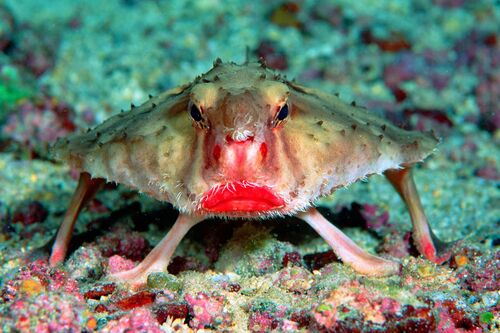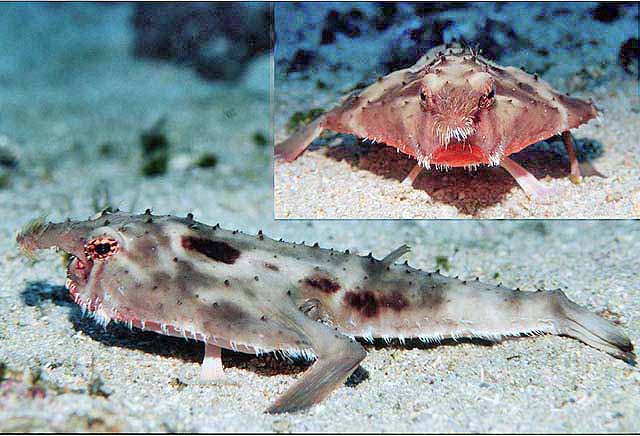The Red-Lipped Batfish (scientific name: Ogcocephalus darwini) is one of the most unique and curious marine creatures found in the deep waters of the Galápagos Islands. Known for its bright red, lipstick-like lips and peculiar body shape, this fish has attracted attention from marine biologists and enthusiasts alike. This article provides a detailed overview of the red-lipped batfish, covering its habitat, diet, behavior, predators, and much more.
One of the most striking features of the red-lipped batfish is its appearance, which sets it apart from other fish species.
Red Lips: As its name suggests, the fish has bright red, almost fluorescent lips, which stand out against its grayish-brown body. Scientists believe these lips may play a role in attracting mates during breeding season.
Body Shape: The batfish has a flattened, disc-like body with a broad, triangular head. It has modified pectoral fins that it uses to "walk" on the ocean floor rather than swim like most fish.
Fins and Tail: While it does have a dorsal fin, the fin has evolved into a spine-like structure used for luring prey. Its tail is short and typically not used for swimming.
Size: The red-lipped batfish is relatively small, growing to an average length of about 40 cm (15.7 inches).

The red-lipped batfish is a species endemic to the Galápagos Islands, meaning it is only found in this specific region. More precisely, it inhabits the waters off the western coast of the islands, with populations recorded around the islands of Isabela and Fernandina.
Depth Range: Red-lipped batfish are typically found at depths ranging from 10 meters (33 feet) to as deep as 120 meters (393 feet). They prefer living in sandy or muddy ocean floors, close to coral reefs and rocky bottoms.
Water Conditions: These fish thrive in colder, nutrient-rich waters, where food is more abundant.
Unlike most fish that swim to move, the red-lipped batfish is known for its unique method of locomotion. It uses its modified pectoral fins to "walk" on the ocean floor. This movement is slow and deliberate, resembling the movement of a bat, which is where it gets part of its name.
The red-lipped batfish is a carnivore, primarily feeding on small marine creatures.
Diet: Its diet includes small fish, crustaceans, shrimp, crabs, mollusks, and worms. Its elongated dorsal fin (also called an illicium) acts as a lure to attract prey. The fish waves this appendage to mimic the movement of small marine animals, which unsuspecting prey may approach, thinking it’s food.
Hunting Technique: Once the prey is within reach, the batfish snaps its mouth shut, capturing the target.
Not much is known about the exact reproduction process of the red-lipped batfish due to its deep-sea habitat and the difficulty of studying it in its natural environment. However, like other batfish species, it is believed to reproduce through external fertilization, where females release eggs into the water and males fertilize them externally.
Despite its unique features, the red-lipped batfish has its own set of predators in the wild. Larger marine animals that prey on smaller fish may view the batfish as an easy meal due to its slow movement.
Natural Predators: Predators of the red-lipped batfish include larger fish such as sharks, groupers, and other large predatory fish species that inhabit the same waters. The slow walking movement of the batfish makes it vulnerable to these faster, more agile predators.
Human Impact: While the red-lipped batfish is not currently endangered, human activities like fishing and marine pollution can pose indirect threats. The Galápagos Islands are a protected marine reserve, but increased human activities in the region could impact their natural habitats.

The red-lipped batfish plays a role in maintaining the balance of its ecosystem by keeping populations of small marine invertebrates in check. As a predator of small fish and invertebrates, it contributes to controlling these species' populations, which helps maintain the overall health of the coral reefs and ocean floor environments where it resides.
Currently, the red-lipped batfish is not listed as endangered or threatened. However, like many marine species, it could face challenges in the future due to environmental changes, overfishing, and habitat degradation. The Galápagos Marine Reserve, where this species resides, offers a level of protection by regulating fishing activities and promoting marine conservation efforts in the region.
The red-lipped batfish is a favorite subject among marine biologists and photographers due to its peculiar appearance and behavior. Its red lips, odd walking style, and unusual body structure make it a unique representative of marine biodiversity in the Galápagos Islands.
The red-lipped batfish is sometimes confused with the closely related Rosy-Lipped Batfish (Ogcocephalus porrectus), which is found off the coast of Peru. Both species share similar body structures but can be distinguished by slight variations in lip coloration and geographic range.
The Red-Lipped Batfish (Ogcocephalus darwini) is an extraordinary fish that exemplifies the wonders of marine adaptation and biodiversity. Found exclusively in the Galápagos Islands, its peculiar red lips, unique walking behavior, and carnivorous diet make it a subject of fascination for researchers and ocean enthusiasts alike. Although not currently endangered, the preservation of its habitat is essential for the continued survival of this intriguing species. By understanding more about its ecology, behavior, and threats, we can better appreciate the importance of protecting marine ecosystems worldwide.